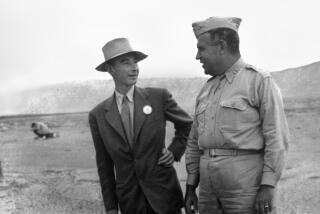How Mad the ‘Mad Bomber’?
SACRAMENTO — He slips into the courtroom through a door on the back wall. At first only the half-dozen men with radio bugs in their ears and bulges under their blue blazers seem to notice him. This is not the wild mountain man seen night after night in the overly familiar arrest footage. He could pass for a law clerk or a college professor, which in fact he once was.
His hair is combed, his graying beard neatly trimmed, his eyes clear and bright. He wears a maroon sweater, a button-down shirt, slacks, dress shoes. He takes his seat at the defense table. His attorneys stand at his elbow, waiting with notes on legal pads. All business, he slips on reading glasses and quickly reviews the paperwork, rendering his responses with whispers and brisk nods.
The biggest surprise is his size. Somehow, the impression had been created of a lanky, strapping fellow. In fact, the star of this month’s trial of the century cuts a small, almost elfin, figure. Maybe it was the distortion of television that made Ted Kaczynski seem so much larger.
Or perhaps it was the power of the bombs he built--or rather, allegedly built.
As the search for jurors resumes, the judge lectures each candidate on the principle of presumed innocence. It is a tough sell. As the Unabomber trial gears up, it seems weighted with the contrary presumption that the bomb-making material, the manifesto rough drafts, the telltale typewriters and travelogues--the whole cache of evidence trucked out of that tiny Montana cabin--pretty much resolved the matter of culpability. Instead, the case will turn on a trickier riddle.
*
It is a question that swirls about the second-floor courtroom, that drifts in and out of the 11 fat binders of legal briefs already generated by the case. It is the question of sanity: Just how mad was this man accused of being America’s mad bomber? Was he sane enough to stop himself? Is he too crazy to kill?
So far the prosecution, which is seeking the death penalty, has been stymied in its attempts to send in an expert to evaluate the defendant. Prosecutors suggest his reluctance--or that of his lawyers, they argue it both ways--is evidence of the defendant’s sanity. Defense experts counter that it confirms the opposite, demonstrating anew his paranoid delusions and schizophrenic tendencies. People sick in the way Kaczynski is sick, they argue, often are the last to know.
“It is not at all surprising in my experience,” a defense psychiatric expert attests in one filing, “that Mr. Kaczynski, with his paranoid delusions, would refuse an evaluation demanded by a government agency that seeks his death. Given the number and type of paranoid delusions held by Mr. Kaczinski, it is my opinion that he would be incapable of trusting the truthfulness and moral integrity of anyone representing the government.”
“It is my opinion,” the prosecution’s expert retorts, “that even in the absence of paranoid delusions, a reasonable person would be appropriately guarded and uneasy with psychiatric examiners employed by a government that is seeking his death.”
Yet this position, the defense fires back, contradicts the government’s own claim that Kaczynski in fact fears being classified a “sicko,” as he put it in a journal, that he does not want his manifesto about society and technology to be dismissed as a lunatic’s ravings.
*
As the briefs and depositions volley back and forth, the armchair psychologists in the courtroom ponder Kaczynski’s appearance. The Ivy League look, the professorial demeanor--are these the markers of a rational defendant facing serious charges or of a delusionary soul seeking to disguise mental sickness so that he might be seen as a serious revolutionary?
And what to make of those expressions of smugness that sometimes flit across his pale face? Could it be that he senses triumph even before the trial testimony has begun? Consider the box of crazy logic he has constructed. He has written that if he is found insane, and his life spared, it will be because his “ideas” alarmed society: “Conformist types seem to have a powerful need to depict the enemy of society as sordid, repulsive or ‘sick.’ ”
Conversely, if he is convicted and sentenced to death, it will only be because the trial demonstrated he in fact was not insane. Thus, he will go to the death room validated, at least in his own mind, as a dangerous and effective enemy of “the machine,” a one-man army of revolution who hurled his bombs in order to make a nation take notice of his brilliance.
Of course, this last position presumes that a sane society would never execute a madman--a presumption that could well be put to the test in the matter of the United States vs. Theodore John Kaczynski.
More to Read
Get the L.A. Times Politics newsletter
Deeply reported insights into legislation, politics and policy from Sacramento, Washington and beyond. In your inbox three times per week.
You may occasionally receive promotional content from the Los Angeles Times.











